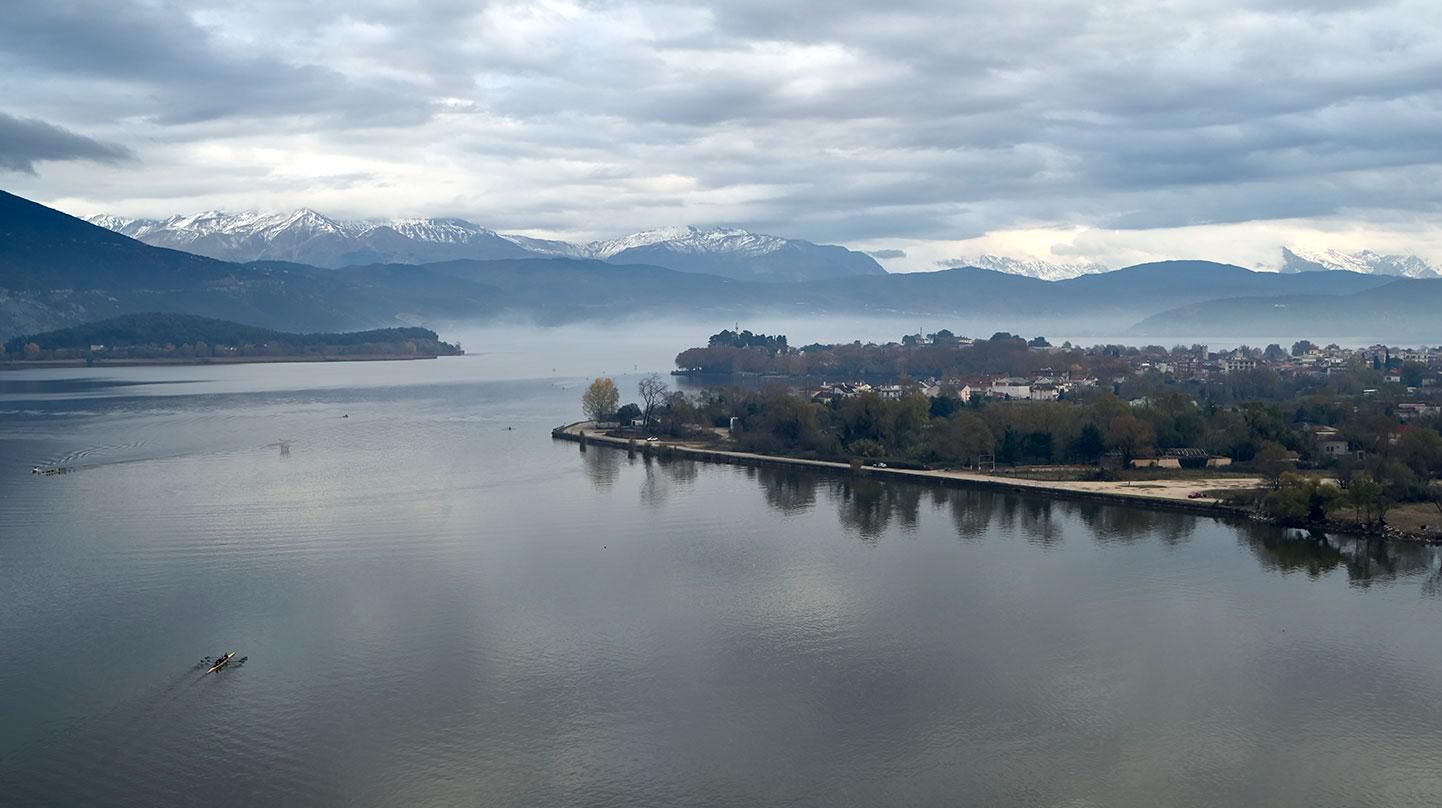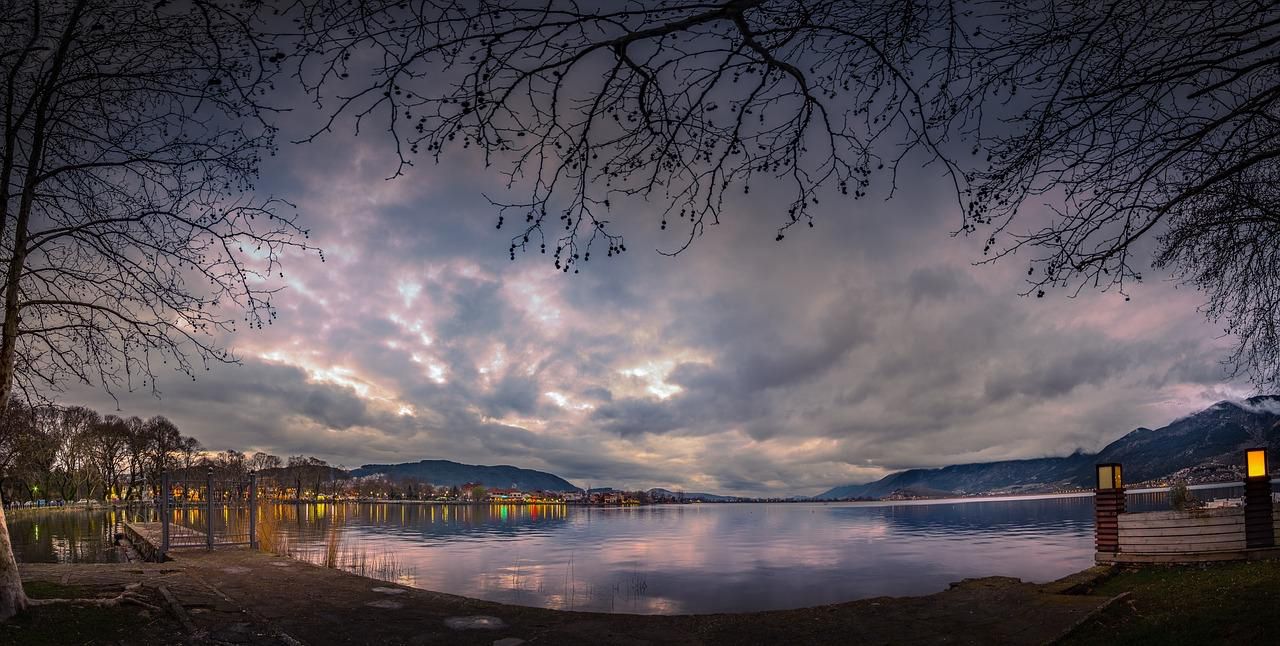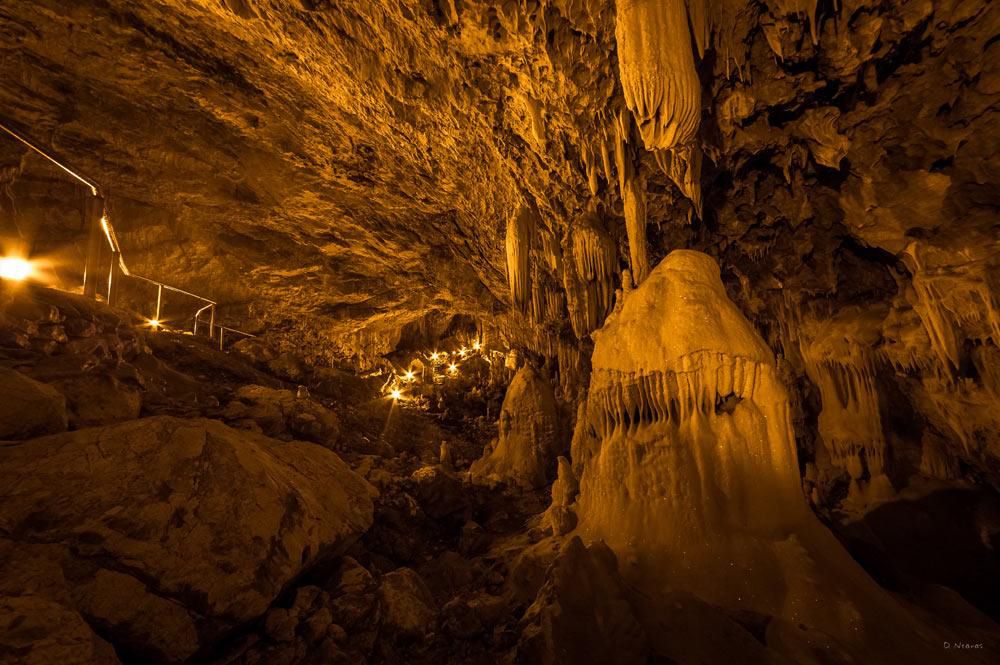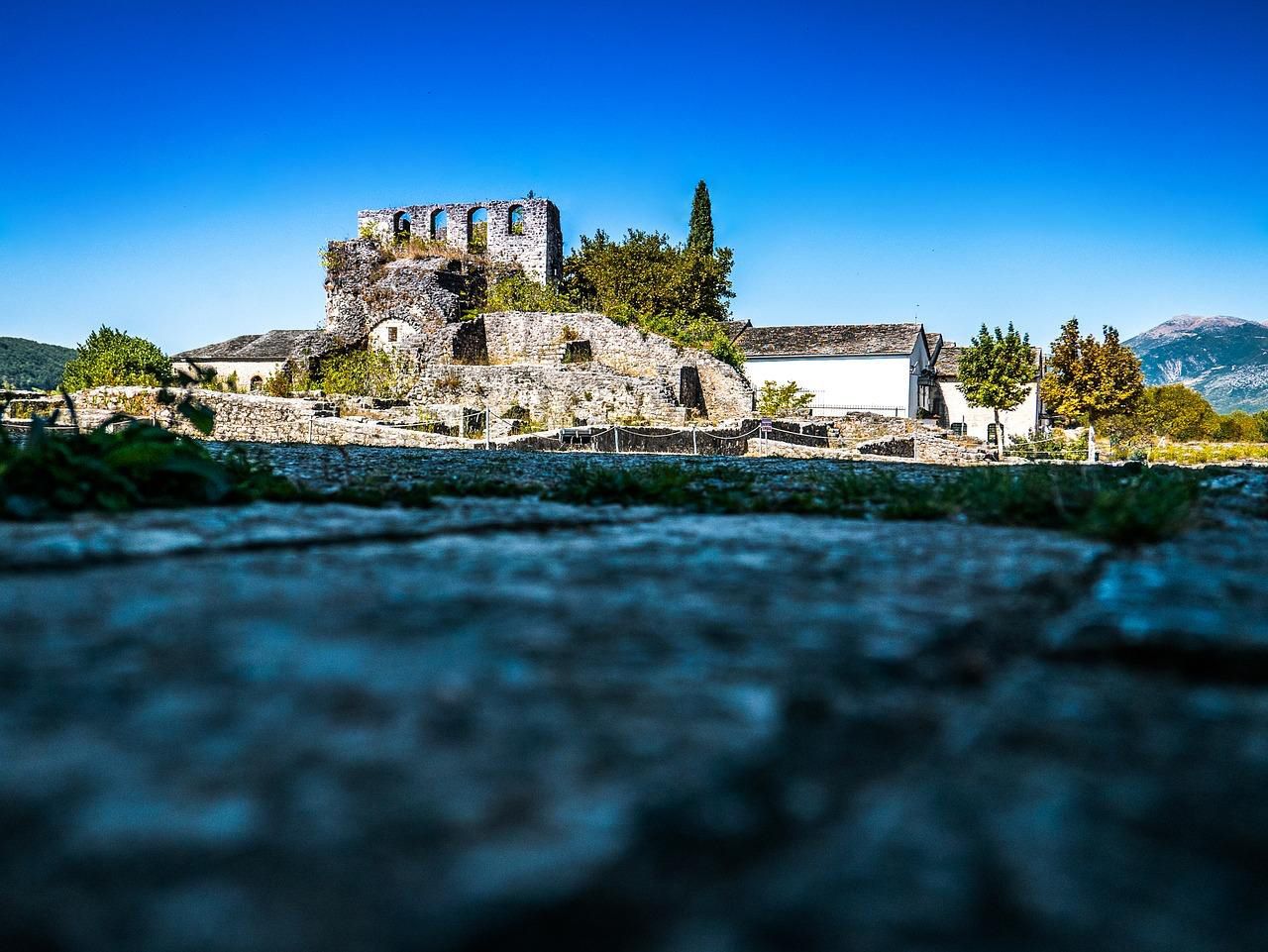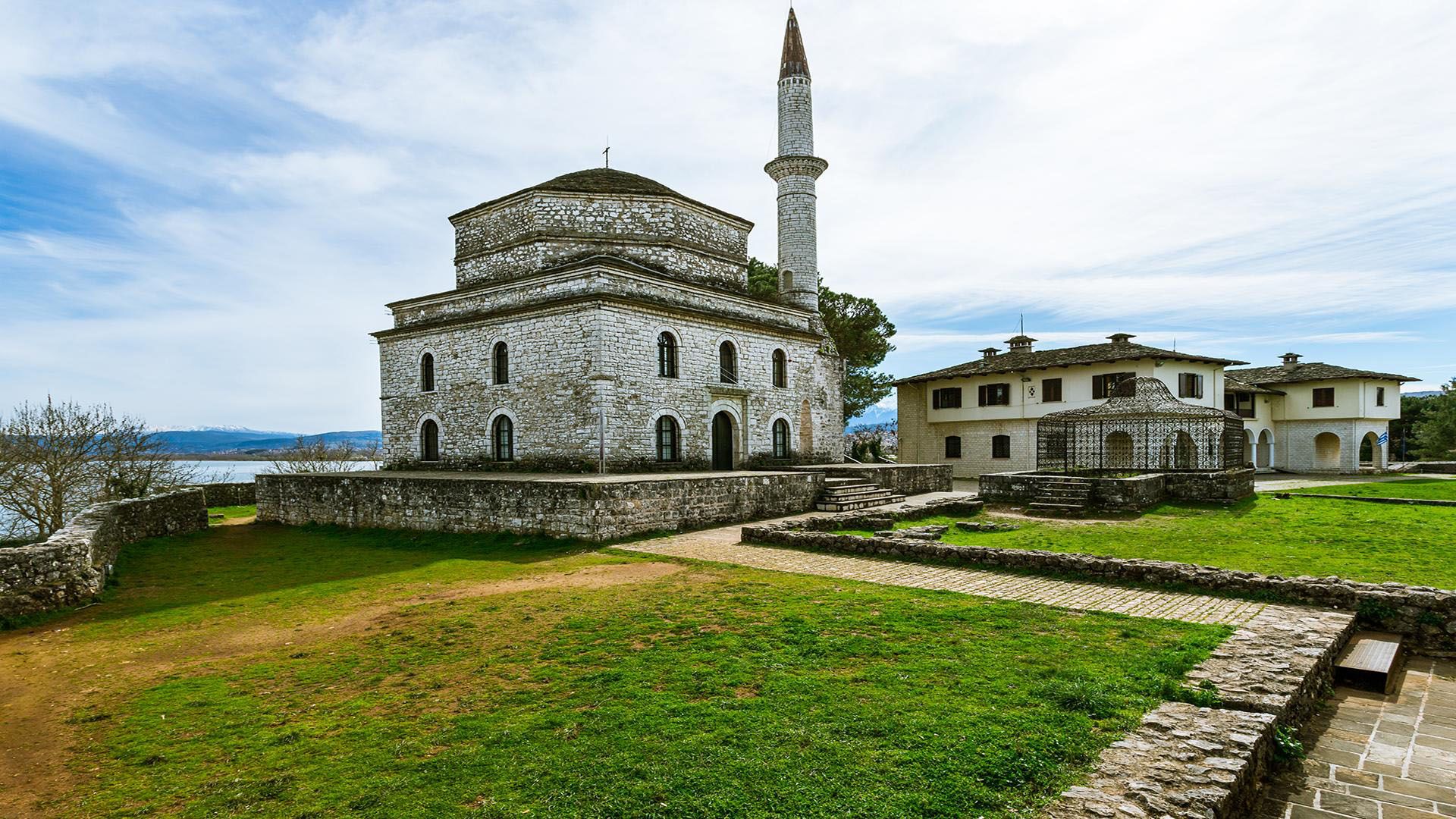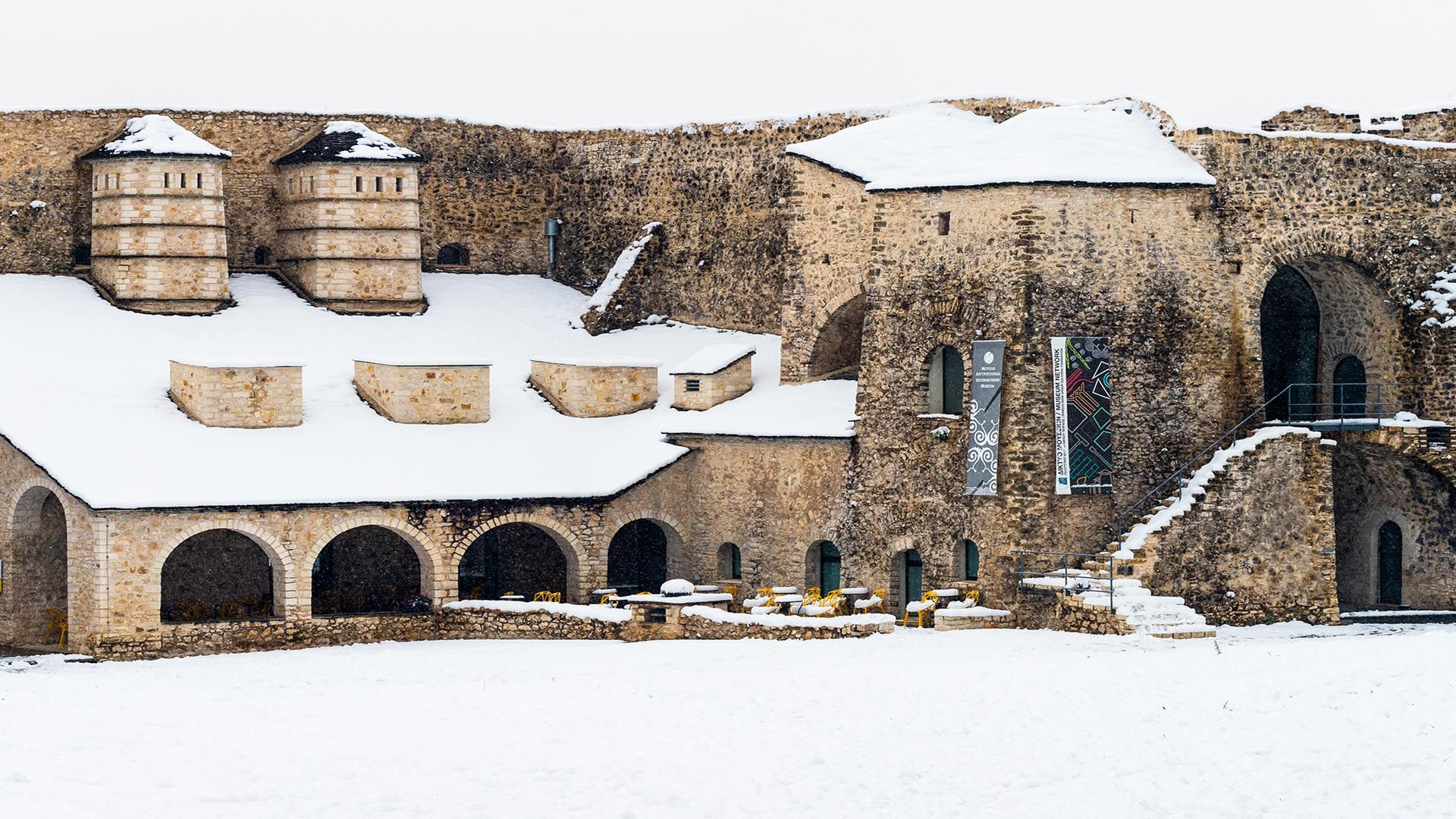EXPLORE THE CITY
THE ISLAND OF LAKE PAMVOTIS
The magic of Ioannina lies on land and water. One of the most scenic and interesting day trips you can enjoy is the visit to the island of Lake Pamvotis, which is located on the northwest side of the lake and adorns its crystal clear waters.
The island of Ioannina is one of the two inhabited islands in lakes of Greece and Europe, and it is a real jewel for the region due to its traditional settlement and its geomorphology. At 1000 meters long, 480 meters wide, and at 59 meters above the lake's surface, there are currently about 100 families who live in the island.
The difference between the two sides of the island is really interesting, as on its western side you will find mild terrain and shores while on the other side the ground is rocky. Its beauty, of course, is also based on the dense vegetation that results from the climate created by the lake.
The settlement of the island will enchant you, with its traditional cobbled streets, the architectural designs that take us back in history and the graceful traditional art shops!
A Monastic Center and cultural heritage
The significance of the island of Ioannina is also due to its status as a monastic center. The five great historical monasteries that have been on the island since ancient times and are inhabited until today, are open to visitors who will have the chance to admire the Greek tradition in a historically and culturally significant environment. It is worth mentioning that the monastic state in the island of Ioannina is the third largest in Greece, right after Mount Athos and Meteora!
The educational tour you have the chance to enjoy in this magical place does not stop at the monasteries! It continues in the Museum of the Pre-Revolutionary Period and "Ali Pasha", in the Monastery of Agios Panteleimonas, where in 1822 the murder of Ali Pasha took place. Inside the museum, where objects that belonged to Ali Pasha and relics from the Ottoman period of Epirus are exhibited, you get the opportunity to discover the history of the place through the centuries.
How?
You can visit the island of Ioannina with one of the boats that start from the "Molos" of Ioannina and operate on a regular route every 30 minutes. This unique route lasts about 6 minutes.
The Lake Hotel offers its services and helps you organize a day trip to the beautiful island of Ioannina.
CYCLING ALONG THE LAKE
The lakeside area of Ioannina is ideal for cycling enthusiasts. Whether you are a cycling expert, or you want to try for the first time with friends and family, or even if you are just a romantic soul that wishes to enjoy a wonderful route with your loved one next to the enchanting nature of Ioannina, cycling along Ioannina Lake is definitely the best choice.
The specially formed cycling path along the lake gives you the opportunity to enjoy the beauty of the area through an experience that combines action and serenity next to the water.
How?
The Lake Hotel, in cooperation with Ioannina's cycling rental companies, ensures the organization of your cycling trip for a safe and unforgettable experience.
PERAMA CAVE
Ioannina will never stop to amaze us!
A truly special tour that will surely be unforgettable to young and old inside the Perama Cave! Perama Cave, just 4 km away from the city of Ioannina, on the road to Metsovo-Trikala, harbors a magical world of explicit beauty.
The historical cave of Perama counts 1.5 million years of life and is located inside the Goritsa hill, above the village of Perama. Visitors are lucky to be able to enjoy the Cave thanks to Anna and Ioannis Petrochilos (founders of the Hellenic Speleological Society), who were the first to explore and map the interior. Its history is of great interest, as evidence about its existence and its use, dates back to the Second World War, where the inhabitants of the area used it as a shelter to protect themselves from the bombings.
Natural Wealth
You cannot leave Ioannina without visiting this paradise of natural beauty! Perama Cave is one of the best caves in the world due to its size and the wide variety of 19 different types of stalactites and stalagmites found inside. Although the total space occupied by the Perama Cave is 14,800 sq. meters, the route allowed for visitors to follow is about 1,100 meters, for safety reasons. These 1,100 meters hide treasures that can be hardly found anywhere else! Successive spaces and walkways, where the temperature varies around 17 ° C, will lead you to a mysterious, fairy-tale like world of stalactites, stalagmites and impressive relief on the walls. Inside the Perama Cave, visitors will come across fossilized teeth and bones of a rare bear species, the “cave bear”, found in 1956 for the first time.
How?
The Lake Hotel, offers you its services and helps you organize your visit to the Perama Cave, in cooperation with local institutions.
THE CASTLETOWN OF IOANNINA
The imposing Castletown of Ioannina is a uniquely preserved historic landmark. It was built by the Emperor Justinian the Great for the fortification of the Byzantine state in 528 AC, and it is the oldest Byzantine castle that operated as a large administrative center in Greece during the time of Ali Pasha. The castle plays an important role for the cultural development of the area, as it is the place where regional Greek education grew, great philosophers taught their theories and chiefs of war studied the art of fighting. Coupled with the great educational history of the monument, inside the walls of this castle a passionate love story arose, since it is the place where Ali Pasha lived with his wife, Kyra-Vassiliki, and fell in love with his son’s mistress, Kyra-Frosini. Legends, myths and traditions will lure its visitor and accompany them as they wander inside its alleys.
Moreover, among the Castle’s houses you will find the Soufari Seraglio, a two-storey building based on a galley system, which was once used as Ali Pasha’s Calvary School. A refreshing stop you would not want to miss is the picturesque café housed in a well-preserved building with chimneys that once housed the kitchens of Itch-Kale, where you can enjoy cool water and beverages. In addition, you can visit the Bohemund Tower, which is one of the most imposing and significant buildings of the Castle, since it was built on the ruins of Ali Pasha’s majestic Serai, that was burned down in 1822.
Besides exploring the foundations of the Castle of Ioannina, you can also visit three of the most important museums of the region inside its gates: the Byzantine Museum in the Itch-Kale Citadel, the Municipal Ethnographic Museum of Ioannina and the Fotis Rapakousis Museum.
BYZANTINE MUSEUM OF IOANNINA
The Byzantine Museum of Ioannina, which was inaugurated in 1995, is located in the southeast acropolis of Itch Kale inside the Castletown of Ioannina and exhibits findings mainly from the Byzantine and post-Byzantine period, such as sculptures, coins, old relics and icons from the 4th to the 9th century. The museum is housed in a two-storey building and keeps its permanent exhibition on the site of the former “Royal Pavilion”, built in 1958 by the Greek army. The exhibition is divided into three sections: Early Christian, Byzantine and Post Byzantine period, and consists of findings that originate from all over Epirus and are indicative of the historical and artistic culture of the wider region. In the same location, during the Byzantine era, the metropolitan church of Taxiarches was placed along with the residences of the rulers, whereas at the end of the 18th century the Seraglio of Ali Pasha was also built there.
An annex of the museum is the Silver-craft Exhibition, which is hosted in the so-called “Treasury”. In the “Fetiye” mosque, which is the northern part of the prayer hall, there is an exhibition that concerns the monument itself, the total of Ioannina’s Castletown, the life and works of Ali Pasha and the general historical and artistic remnants of his era.
In addition to the permanent exhibition of the museum, which includes findings of exceptional value, the Byzantine Museum also hosts a ceramics, fresco, mosaic and stone preservation workshop. Furthermore, it has the capacity to host periodical exhibitions, theater shows and educational programs, and also has a shop for you to buy your own souvenirs.
The Byzantine Museum lies in the heart of a location with exceptional cultural significance at the Citadel of Ioannina’s Castletown and exhibits a great part of Epirus’ history, as it has been revealed from the excavation findings on the region.
THE SILVERSMITHING MUSEUM
The Silversmithing Museum is located in the southeast acropolis of Ioannina’s Castletown, next to the building of the old cookhouses. The aim of its exhibition is to preserve the local craftmanship and highlight its technological development in the region over the years, as well as praise the cultural background of the society of Ioannina in which it flourished. The main theme of the exhibits is the technological progress of silversmiths during the pre-industrial period in the wider region of Epirus.
Oriented mainly to the post-Byzantine period, from the 15th century onwards, the exhibition of the Silversmiths Museum does not fail to include references from the distant past, as the technology used to produce silverware often goes back to much earlier years. With two levels of exhibition areas and a variety of interactive digital games, parallel educational programs, documentary films and more, the Silversmithing Museum of Ioannina offers a complete learning experience by activating all senses.
Discover the traditional techniques of shaping and decorating silverware, get to know first-hand each technique’s different stages necessary to the creation of the final product and witness an exceptional historical and cultural procedure. The second level of the exhibition hosts the collection of works from the 18th to the 20th century with elaborate artworks, jewelry, weapons and items of personal or household use. Moreover, the exhibit includes works of modern local craftsmanship by silversmiths who are active in the wider region of Epirus and perpetuate a unique tradition, by both evolving its techniques and keeping the traditional elements that their predecessors valued.
THE MUSEUM OF ALI PASHA AND REVOLUTIONARY ERA
The Museum of Ali Pasha and Revolutionary Era is located in the beautiful island of Ioannina and hosts some astonishing works of art of the locals’ everyday life, silverware, Greek ceramics, guns, traditional costumes of the Epirus region, paintings and authentic folklore objects from the late 18th to the middle of the 19th century. In this museum you will also find the famous flintlock of Ali Pasha and the silver sword of the national benefactor Apostolos Arsakis.
The museum’s premises are divided into thematic sections, that include the Ali Pasha’s room, where he received a deadly shot during his engagement with a Turkish soldier, and the torture room that Ali used to keep his prisoners. The colorful flowers of Islam, tulips and cloves adorn the 17th century Iznik plates in the room of Sultan Mahmoud II, the one who ordered the murder of Pasha because he supported the Greek community of the region.
Witness the glamor of the silver jewels that once adorned the beautiful females of the palace and visit a Winter Onda, a representation of a typical living room of Ioannina during the Ottoman era, with Ali Pasha and his wife’s emblems. The collection of the museum takes its name from its director, Fotis Rapakousis, who was inspired by his grandmother’s stories, fell in love with the culture and history of his homeland, Epirus, and led a creative path as a collector.
HISTORIC CENTER OF IOANNINA: LOCAL FLAVORS AND TRADITIONS
The myths and legends of the historic center of Ioannina, which stretches along the lake, invite you to roam the streets of this beautiful city and explore the history of different cultures and eras. The famous Clock of Ioannina on the north side of the town square is decorating the city, like another of its many beautiful gems, for many centuries and was built in 1905 by the great architect Pericles Melirritos. Walking down the main street you will find yourself surrounded with local folk art shops with souvenirs and goldsmiths hidden in every corner.
The smell of local delicacies will embrace you amongst the old trade galleries and folk houses, as the alleys with traditional cafes and modern bars will be bustling with laughter and music. Here you can try the traditional beverage ‘tsipouro’ and the famous ‘baklava’, which holds its origins from the Middle East and the former Ottoman countries.
By all means, you shouldn’t miss the chance to try the well-known varieties of local dairy and cheese products with unique quality! These flavors travel from past generations and always remain unique, such as the famous traditional Metsovone and other similar dairy products with oregano and crushed red pepper. Just a few blocks away you will definitely come across a store that features traditional desserts with mushroom as the main ingredient, natural herbs and Zitsas wines, composing a flavor palate that combines the sea aura and the wild beauty of the mountains. The lemon balm, mint and wild blue berry, in addition to their beneficial properties, give a unique sensation, which is inherent in the aura of the Epirotic region.
ARCHAEOLOGICAL MUSEUM OF IOANNINA
The Archaeological Museum of Ioannina, located close to the historic Clock of the town’s main square, exhibits findings that cover a long period from the Lower Palaeolithic era (of 250,000 years ago) when man first appeared in Epirus, until the late Roman times during the 3rd century AD. A special place amongst the findings is occupied by the artifacts that originate from the sanctuary of Ancient Dodona, the worship center of Zeus and Dione at the foot of Mountain Tomaros.
In total, the new permanent exhibition of the museum includes about 3,000 archaeological findings from the entire region of Epirus while its structure is divided into three axes: one chronological, one geographical and one thematic. The countenance of the area is depicted in the elaborate exhibits of the past, uniting the most important aspects of the location’s historical origins and composing the brilliant course of the Epirotic region in antiquity. The museum’s exhibition also hosts findings from the archaeological sites of the ancient city of Kassope, the Nekromanteion of Acheron (oracle of the dead) and Vitsa of Ioannina, the largest village of central Zagori next to the famous Vikos Gorge.
The Archaeological Museum of Ioannina was built in the 1960s by the eminent Greek architect Aris Konstantinidis and has received since some significant donations, such as the Melas Collection, with findings of Greek antiquity. From the 19th century’s European travelers to today’s museum visitors, the history of Epirus continues to spread and enchant those who choose to explore it.
MUNICIPAL ETHNOGRAPHIC MUSEUM OF IOANNINA
Housed in the mosque of Aslan Pasha, ruler of Ioannina during the years of 1600 and 1612, the Municipal Ethnographic Museum hosts three collections that represent the Castle’s residents during its Christian, Jewish and Muslim evolutionary history. The museum was built in the location that formerly housed the temple of St. John the Baptist, during the Byzantine era, who is said to have given his name to the city of Ioannina. The mosque of Aslan Pasha was built afterwards on the Castletown’s rock in 1618.
Today, you can visit the exhibition of the Municipal Ethnographic Museum at a site of paramount importance to the area and see the findings that are preserved from donations of eminent families of Epirus and date back to the 18th until the 10th century, such as arms and costumes from the period of the Ottoman domination of the region. In addition, the exhibition includes objects such as ecclesiastic silverware, vestments and books from the collection of Archibishop Spyridon, the elected Metropolitan of Ioannina in 1916.
The Jewish collection hosts costumes from the Jewish community of Ioannina, while there are also Muslim textiles, books and bronze objects of the Ali Pasha era exhibited in the central collection of the museum. A powder-keg, the cave of Dionysios Skylosophos, as called by his rivals, and a medieval tower surround the main exhibition of the Municipal Ethnographic Museum. At this location there are also a Turkish library and Ali Pasha’s Cavalry School that you can visit. A tour at the Municipal Ethnographic Museum of Ioannina is enough for any visitor to get acquainted with the history of the Epirotic region and identify with the local traditions that are deeply rooted in the area.
MUSEUM OF GREEK HISTORY, WAX EFFIGIES "PAVLOS VRELLIS"
History meets the artistic creation through the hands of an experienced craftsman, who designs and shapes important historic figures of the Greek Revolution. Pavlos Vrellis, born in Ioannina in 1923, painted and sculptured stones and wood from a small age during the First World War. 50 years later, in 1985, a museum full of wax art that respects the history and tradition of this country, will open its doors to present the public a unique opportunity to witness history through an important man’s creations.
The museum of Greek History “Pavlos Vrellis” is housed in an 18th-century Urban Castle of local architecture outside of Bizani-Ioannina, an hour away from Lake Pamvotis. 150 natural-size waxworks created as faithful and original representations, compose a unique experience of a historical journey that is thematically divided into exhibits prior to the 1821 War of Independence, exhibits from 1821 until the 20th century and separate references and tributes to important Greek personalities, such as Officer Pavlos Melas and Lady of Ro.
The “Women of Pindos”, “The Battle of Crete”, “Cyprus” and “German Furnaces” come alive in flesh and bone, making this museum’s visit an unforgettable experience. Vrellis himself has also renovated and redesigned the exterior of the museum, while always maintaining his respect for the traditional Epirotic architecture and his love for nature. Vrelli’s work is truly remarkable if one considers that for some of his wax creations, the means he possessed were meager: “I am really struggling to bring people to life when the reports I have about them are few or less (for Dionysius the Philosopher, I actually had only one sketch) ".
